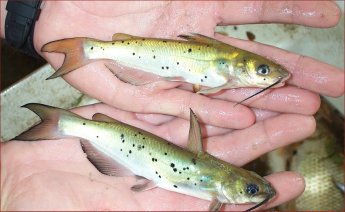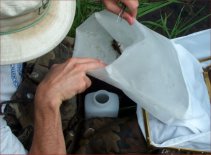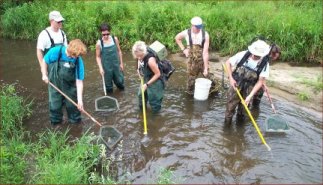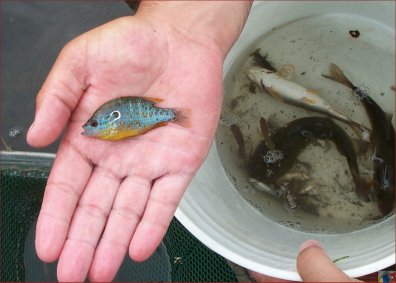Biological Assessment of Iowa's Streams and Rivers
Introduction

Since 1994, the Iowa Department of Natural Resources and the State Hygienic Laboratory (SHL) have sampled fish and benthic macroinvertebrates across the state to assess the biological integrity of Iowa's streams and rivers. Benthic macroinvertebrates are small animals, such as aquatic insects, crustaceans, leeches, and snails that live on the stream bottom. The numbers and types of aquatic organisms found in a stream are useful indicators of the stream's health because they reflect changes in water quality and habitat.
Biological assessments are an important part of the 305(b) Water Quality Reporting process, as they provide quantitative data on which assessments of water quality can be made.
BioNet is the application used by the Iowa DNR to store and analyze this biological assessment information and make it available for internal use, external agencies, and the public.
Sampling
Since the program began in 1994, biological assessments have been performed at 1559 locations throughout the state. 1,679,211 fish and 1,385,593 invertebrate taxa were collected and identified during this time.
Sites within the biological monitoring program are divided into three major types- Wadeable, Large Rivers, and Headwater streams.
- Wadeable streams make up the vast majority of all sites sampled within the program. These are sites that are easily sampled with standardized sampling gear by staff members wading into the stream and collecting the data. Because this is the most common stream type, all Fish and Benthic Macroinvertebrate Indicies of Biotic Integrity (IBI) are calibrated to streams this size.
- Large Rivers, formerly known as "Non-wadeable" sites, are much larger streams and rivers that are too deep to wade and require the use of a specially equipped boat with electroshocking gear and large dip-nets. Fish sampling is not as effective, due to the difficulty in capturing smaller fish in the deeper water and stronger current. Benthic macroinvertebrate sampling is also extremely difficult in these types of rivers.
- Headwater streams are found at the upper reaches (headwaters) of streams. These are very small streams, and can often be sampled with just one backpack shocker, rather than the 2-3 typically used in wadeable streams. Because the fish and benthic macroinvertebrate communities are much different in the upper reaches, a separate IBI is currently under development.
There are two main statuses assigned to invdividual sites- Reference and Survey sites. All other statuses are derived from these two categories.
- Reference sites represent stream conditions that are least disturbed by human activities, and are used to set biological criteria for measuring the health of other streams within the same ecoregion. To maintain a baseline for biological quality, twenty different reference sites are monitored each year, and each individual site is sampled on a 5-year schedule.
- Survey sites are sampled to determine if the stream's biological health is impacted by disturbances such as channelization, livestock grazing, manure spills, wastewater discharges, point and non-point source pollution, and urban runoff. Currently, the biological assessment program is able to monitor approximately 40 different survey sites per year.
Sampling Methods
 Stream biological sampling is completed from July 15 - October 15 while stream flow levels are relatively stable. The length of stream segment sampled ranges from aprroximately 500 to 1200 feet, depending on stream width and how frequently stream habitat features are repeated. Sampling frequency ensures that important habitat niches utilized by benthic macroinvertebrates and fish are adequately represented. Two types of benthic macroinvertebrate samples are collected: standard habitat and multi-habitat. Specific types of sampling gear are used to collect standard habitat samples from rock or wood surfaces in flowing areas of the stream. A Hess sampler or a Surber sampler is used to sample benthic macroinvertebrates in streams which have riffles comprised of gravel and cobble substrates. Artificial habitats constructed of small, wood plates are used in streams which lack riffle habitat. The multi-habitat sample is collected simply by handpicking organisms from various types of habitat including aquatic vegetation, boulders, leaf packs, overhanging vegetation, root mats, and woody debris. The data from standard and multi-habitat samples estimate how many types of benthic macroinvertebrates are present, and the abundance of each type in relation to the whole sample.
Stream biological sampling is completed from July 15 - October 15 while stream flow levels are relatively stable. The length of stream segment sampled ranges from aprroximately 500 to 1200 feet, depending on stream width and how frequently stream habitat features are repeated. Sampling frequency ensures that important habitat niches utilized by benthic macroinvertebrates and fish are adequately represented. Two types of benthic macroinvertebrate samples are collected: standard habitat and multi-habitat. Specific types of sampling gear are used to collect standard habitat samples from rock or wood surfaces in flowing areas of the stream. A Hess sampler or a Surber sampler is used to sample benthic macroinvertebrates in streams which have riffles comprised of gravel and cobble substrates. Artificial habitats constructed of small, wood plates are used in streams which lack riffle habitat. The multi-habitat sample is collected simply by handpicking organisms from various types of habitat including aquatic vegetation, boulders, leaf packs, overhanging vegetation, root mats, and woody debris. The data from standard and multi-habitat samples estimate how many types of benthic macroinvertebrates are present, and the abundance of each type in relation to the whole sample.
 Fish are sampled using electrofishing gear. Battery-powered backpack shockers are used in small streams and a generator-powered barge shocker is used in larger streams. Sampling is accomplished in one pass (downstream to upstream) through the sampling reach. The electrical current supplied by the gear temporarily stuns fish swimming near the shocker electrodes. The fish are netted and transferred to a holding bucket or live well for processing. The fish are identified, counted, examined for diseases and parasites, and then released to the stream.
Fish are sampled using electrofishing gear. Battery-powered backpack shockers are used in small streams and a generator-powered barge shocker is used in larger streams. Sampling is accomplished in one pass (downstream to upstream) through the sampling reach. The electrical current supplied by the gear temporarily stuns fish swimming near the shocker electrodes. The fish are netted and transferred to a holding bucket or live well for processing. The fish are identified, counted, examined for diseases and parasites, and then released to the stream.
Ecoregions and Reference Streams
Ecological regions (or "ecoregions") and reference stream sites provide a framework for stream biological assessment. Ecoregions are areas in which there is relative similarity among various ecological systems, such as lakes, streams, and wetlands. Iowa has ten ecoregions that are defined by geology, landform, land use, natural vegetation, and soils. Stream reference sites have been identified in each ecoregion. Reference sites represent relatively natural stream habitats that support healthy biological communities. The Iowa DNR is using reference sites to establish biological criteria for determining the health status of other streams. To minimize the risk of water quality impacts, reference sites are not located near known pollution sources. Reference sites are bordered by well-vegetated buffer strips and have good physical habitat characteristics.

Biological Indicators
The Iowa DNR uses a Benthic Macroinvertebrate Index of Biotic Integrity (BMIBI) and a Fish Index of Biotic Integrity (FIBI) to obtain a broad assessment of stream biological health. The BMIBI and FIBI combine many individual measurements or “metrics” to obtain a more complete estimate of stream health. A metric, as the term is used here, is any characteristic of the aquatic community that can be measured reliably and reflects upon stream health. The BMIBI and FIBI both contain twelve metrics. The metrics relate to species diversity, relative abundance of sensitive and tolerant organisms, and proportion of individuals belonging to specific feeding and habitat groups. The FIBI also has a fish abundance metric and a fish health condition metric. The individual metric scores are summed to obtain an index score ranging from 0 (poor) – 100 (optimum). Qualitative scoring ranges of poor, fair, good, and excellent have been established. To determine whether a stream is meeting expectations for supporting aquatic life, the Iowa DNR compares the BMIBI and the FIBI scores from that stream against the range of index scores from reference sites located in the same ecoregion.
Biological Resources
Helping to inventory Iowa’s biological resources is an important aspect of the biological sampling project. The loss of many fish and freshwater mussel species that once lived in Iowa has been reported. Despite these losses, Iowa’s streams support a sizeable amount of biological diversity. So far, 133 species of fish and 959 species of benthic macroinvertebrates have been collected. Information from these collections helps determine the geographic ranges of fish species of endangered or threatened status in Iowa. In the case of benthic macroinvertebrates, many new discoveries are being made. For example, SHL staff have documented numerous mayfly and stonefly species not previously reported for Iowa. Minnows are the most diverse group of fish (33 species) living in Iowa’s streams. Perches (including darters) (13 species), Suckers (11), and Sunfish (10) have the next largest numbers of species. The midge larva(Chironomidae), an immature life stage of aquatic fly, is the most frequently collected type of benthic macroinvertebrate. Other common benthic macroinvertebrates are net-spinning caddisflies, mayflies, riffle beetles, and aquatic worms. Ten fish species and ten types of benthic macroinvertebrates account for more than 60% of all organisms sampled.
Biological Assessment Implementation
Information collected in the Iowa DNR/SHL stream bioassessment project is used to guide surface water management decisions. Aside from assisting in the development of 305(b) Water Quality Reporting, several other uses of bioassessment information include:
- Stream status and trend monitoring
- Water quality standards development and refinement
- Problem investigation
- Evaluation of pollution control and habitat restoration actions
- Development of restoration plans for impaired waters
- Conservation of biological resources
- Evaluation of stream recovery following fish kills
